When you realize it's time to start consolidating workflows, automating tasks, following customer journeys, and just plain working better across teams, you know it's time for a CRM solution. Just about anyone shopping around for customer relationship management tools is going to run into the Zendesk vs. Salesforce conundrum—they're two of the biggest names in the business.
While these two platforms do many of the same things, I found that the user experience and specific use cases are pretty distinctive.
After spending a lot of time testing both Zendesk Sell and Salesforce Sales Cloud, I'll share how these CRMs stack up.
Zendesk vs. Salesforce at a glance
Zendesk has a simpler, more intuitive structure and a top-notch user experience that makes it quick to onboard and easy to roll out.
Salesforce can be more complicated than Zendesk and may require more involvement from dev teams, but it features a wider range of business cloud products for scaling enterprises with complex needs.
|
Zendesk |
Salesforce |
|---|---|---|
Out-of-the-box utility |
⭐⭐⭐⭐⭐ Zendesk is extremely simple to use and should be quick to onboard; most features are no-code or low-code and should involve little IT involvement |
⭐⭐⭐⭐ While Salesforce is relatively simple to onboard, it may require more IT involvement for advanced features, particularly at scale |
Range of use cases |
⭐⭐⭐⭐ While Zendesk would be appropriate for use cases in virtually any industry, reporting and automation features are a little more slanted toward issue management |
⭐⭐⭐⭐⭐ Salesforce could easily be implemented for use cases in just about any industry |
UX |
⭐⭐⭐⭐⭐ With modern design, a simple dashboard, and clean interfaces, user experience is a clear strength for Zendesk |
⭐⭐⭐ It can be a little tricky figuring out Salesforce's structure, finding specific features, and implementing advanced features |
Scalability |
⭐⭐⭐⭐ Zendesk offers a strong suite of tools and advanced features for enterprise adoption at competitive pricing |
⭐⭐⭐⭐⭐ Few CRMs can match Salesforce's range of cloud-based solutions to help enterprises scale |
Automation |
⭐⭐⭐ Automation tools are somewhat limited and can be a little complicated to implement; triggers are catered more heavily toward issue management |
⭐⭐⭐⭐ Salesforce has a lot of automation tools, though many require higher pricing tiers to access; implementation can be complicated |
Advanced AI |
⭐⭐⭐⭐⭐ Thanks to a recent OpenAI partnership, Zendesk has impressive customer service and generative AI capabilities |
⭐⭐⭐⭐⭐ Salesforce beat Zendesk to the punch on generative AI via OpenAI and has slightly more sophisticated AI tools |
Reporting |
⭐⭐⭐ Reporting options are a little limited in Zendesk and skew slightly toward issue management metrics |
⭐⭐⭐⭐ There are more reporting options in Salesforce, but there's still room for improvement in terms of presentation options and ease of use |
Overall value |
⭐⭐⭐⭐⭐ Zendesk offers many of its most interesting features at lower pricing tiers, which are priced significantly lower than Salesforce's comparable packages |
⭐⭐⭐ Salesforce's renowned software quality isn't value-priced and tends to block key features at lower tiers; advanced cloud products can be very expensive |
Integrations |
⭐⭐⭐⭐⭐ 1,200+ integrations; integrates with Zapier |
⭐⭐⭐⭐⭐ 2,500+ integrations; integrates with Zapier |
Zendesk is a better out-of-the-box CRM
I'll preface this section by admitting it's a little nitpicky, but let's call it like I see it: Zendesk is just plain better when it comes to raw user experience. The design is modern, the layout is sensible, the features are responsive, and everything just looks clean and operates seamlessly. Even users with no CRM experience should be able to hit the ground running with Zendesk.

Setup is simple. You can easily import existing contacts, connect your email or phone, fill out your profile, explore onboarding guides (including demos and videos that are actually useful), and get a good lay of the land with little to no training. There's a generally predictable logic to navigating the dashboard, with all the expected CRM building blocks clearly defined. Check in on tasks, leads, appointments, reports, contacts, and deals in their dedicated tabs, or create entries for any of the above from any screen via the omnipresent Add dropdown.
When I log into Salesforce, I get a slight sense of being overwhelmed. Look, I know it's not really that much harder to sift through the forecasts and campaigns and separate dashboards to find your leads in Salesforce. And I know there are plenty of very happy Salesforce users out there who don't feel the same way at all. But considering that most daily CRM users don't actually need regular access to all the stuff Salesforce's dashboard throws at you, I just think it's a better experience to give people fewer, more likely to be useful things to click on without making them create multiple custom dashboards.
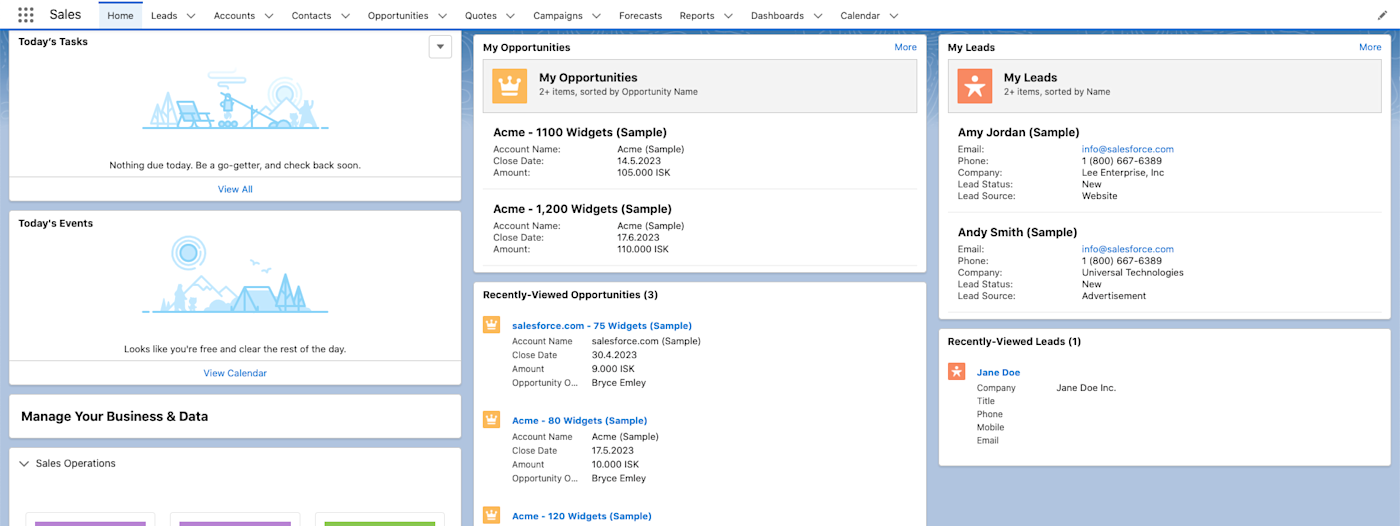
In terms of its presentation, there's something about Salesforce that's always made me think of the word "relic." I don't necessarily mean that as an outright insult, but it just doesn't feel like updating design and UX have been a top priority. It's got a vaguely mid-aughts, overly corporate type of vibe that just doesn't make me want to spend my whole day in it. You basically need a Salesforce implementation expert to help you set up the platform (which is available for an extra fee with the Premier and Signature Success Plans).
It's pretty clear that Zendesk made it a priority to create an attractive, contemporary workspace, which is a benefit of its relative newness in the CRM landscape.
Salesforce has more dynamic use cases for scaling enterprises, but Zendesk isn't far behind
One of Salesforce's major calling cards is its range of use cases. To keep things simple, I'm focusing on Salesforce's Sell product, which is a pretty traditional sales process CRM, but that's really just a single limb on a big tree (not a real saying, but you get the idea).
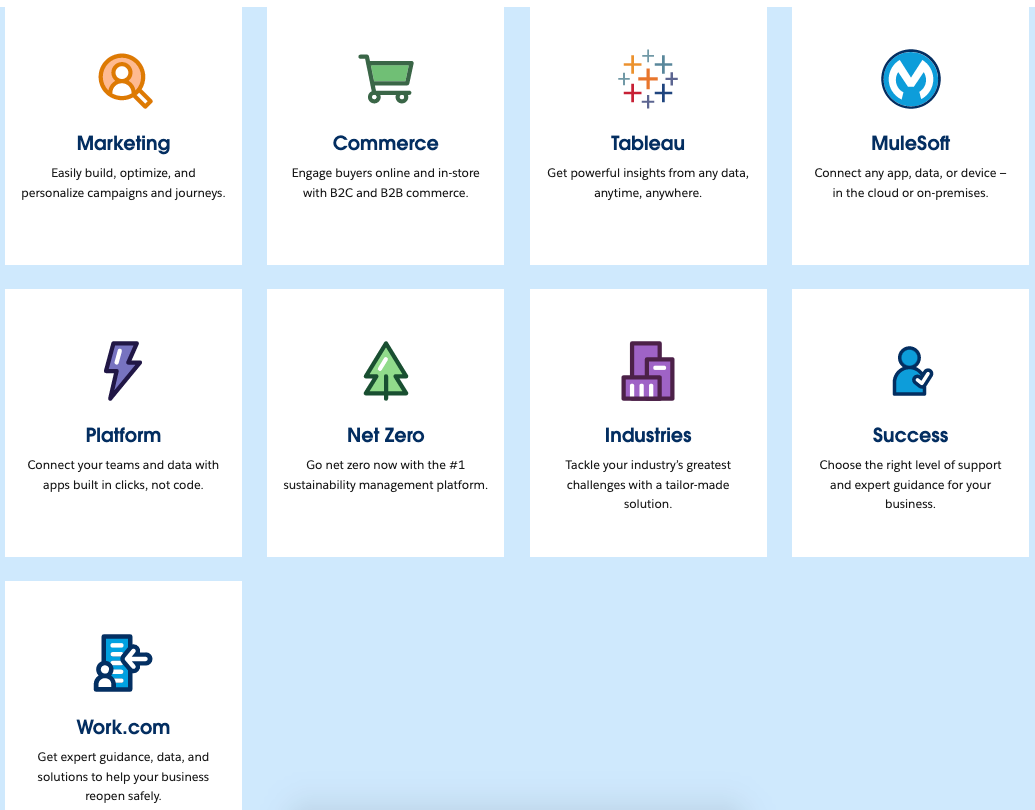
Salesforce also offers cloud-based products for tasks like loyalty management and advertising (Marketing), scalable B2B sales and order management (Commerce), premium forecasting and internal trend identification (Tableau), custom app building (Platform), and even sustainability management (Net Zero).
Chances are, if you're interested in adding this kind of functionality, you already have a capable dev or IT team, but it's worth noting that adding complexity to Salesforce can require some implementation resources—or at least a sizable licensing fee. Its MuleSoft Composer tool, for example, allows account holders to add code-free task and third-party app integrability to the native UI starting at a cool $27,000 per year.
In comparison, Zendesk doesn't have the same range of built-in use cases. But while it's a more generally streamlined offering, it's still very adaptable beyond its sales-centric CRM. While it may not have pre-built products for sustainability management or return-to-work planning, it does offer catered utility for even compliance-rich industries like manufacturing, healthcare, finance, and government.
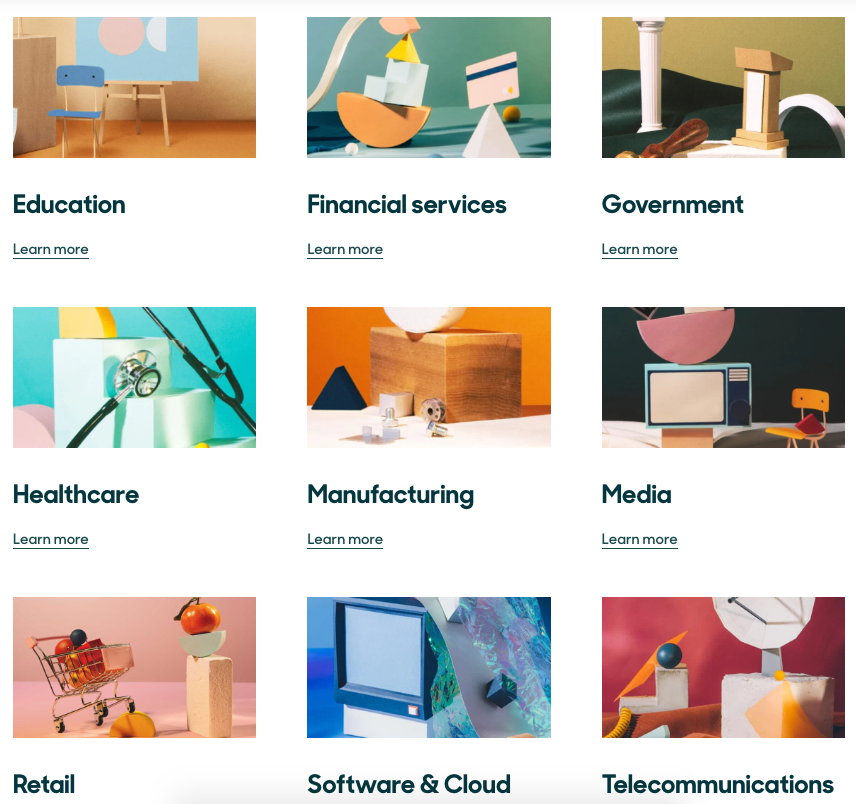
Zendesk also has a handful of supplemental products to round out its sales CRM with enhanced customer support (Support), knowledge management (Guide), community forums (Gather), live chat (Chat), voice chat (Voice), and reporting (Explore).
For more bespoke implementations, Zendesk's Sunshine™ is pretty compelling (not to mention impressive that they were able to trademark "sunshine"). This is Zendesk's underlying open-standard infrastructure, and by accessing it, developers can adapt the platform to create customized user experiences, alter workspaces, and integrate systems on top of existing data for $495 a month.
Both have automation and advanced AI tools, but Salesforce's are more sophisticated
I wouldn't say automation is one of Zendesk's or Salesforce's strong suits, but users of either platform will probably be able to find uses for it. Their AI offerings, on the other hand, are pretty compelling. Both companies offer advanced AI and generative tools via OpenAI as of spring 2023.
Let's look closer at each set of tools.
Zendesk automation vs. Salesforce automation
Within the Admin panel, Zendesk users can set up automation conditions and trigger sequences (very similar concepts that are separated in the panel) based on ticket-related criteria like form submissions, channel sources, time since assigned, tags, and ticket types.
Users who aren't specifically using the platform for ticketing may not find as much utility here. Not to mention the dropdown design interface itself isn't nearly as modern as the rest of the platform and can be a little hard to follow—I much prefer point-and-click trigger visualizations.
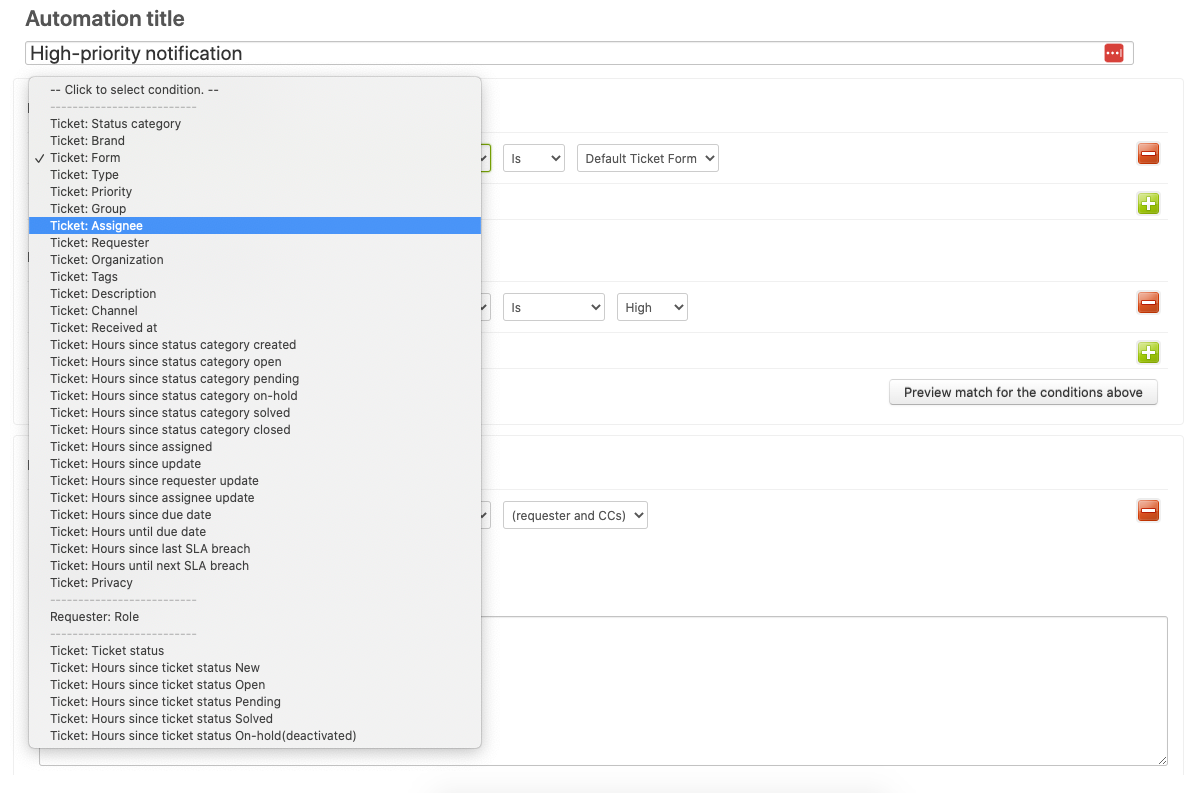
Service agents should find the automation and trigger features pretty useful, even if other CRM users might not. It's also worth noting that the chat feature has its own separate dashboard with a similar but slightly more user-friendly automation interface, but it still doesn't have a clean real-time visualizer like HubSpot or Zoho.
Salesforce's automation offering is more dynamic, but still not the simplest thing to roll out. Lower-tier account holders can access its Process Builder interface, which is pretty decent, but I still found it somewhat confusing sorting through its complicated series of dropdowns.

If you want to schedule automations rather than trigger them only when certain conditions are met, you'll need to upgrade. (At the Professional tier users also get access to the more sophisticated Flow Builder.) Within the Salesforce automation module, you can also access flows for automating business processes, automation sequence templates, and an interesting AI-based automation tool, which I'll get into more below.
Zendesk AI vs. Salesforce AI
Zendesk's OpenAI-partnered customer service AI is informed by years of accumulated interactions, making it an extremely smart tool for service management. With a suite of AI tools, agents can get more information about customers prior to interaction, benefit from smart ticket sorting, gain contextual insights, get suggestions for related articles and existing knowledge, and automate common tasks.
Its AI-driven chatbots are extremely simple to deploy and are very effective for solving simple customer issues without agent input, thanks to machine learning capabilities that help craft more informed automated responses to customer queries.
Through an OpenAI partnership, Zendesk's AI helps create relevant macros to automate common tasks, identify gaps in knowledge bases then fill them with new articles, and auto-generate potential agent responses. All this is an expansion on its native AI functionality, which already packs in tools like advanced analytics, adaptive messaging, and knowledge base management. Some of these features, like a limited number of automated answers, are even available at all pricing tiers, but the Advanced AI package is just $50 per month extra and expands to include advanced bots, macro suggestions, triage, and agent insights.
Salesforce barely beat Zendesk to the punch to offer the first generative AI integration for a CRM, also via OpenAI, which is also part of a $50 per month package. Dubbed Einstein GPT, Salesforce's Einstein can do things like gain intelligent insights from user and customer behavior, suggest actions, and automate scheduling, but Salesforce leans hard into its generative capabilities.
Using Salesforce's proprietary modeling, Einstein can create original knowledge bases, web content, agent responses, and other omnichannel messages. Einstein also drives Best Action, a module that allows users to create smart assistants with point-and-click simplicity that integrate machine learning to turn data into predictive suggestions and action strategies.
Zendesk is the better overall value but is slanted slightly toward issue management for reports and automations
Depending on your needs, you could rack up a monthly spend on Salesforce that equates to well over some employees' whole salaries. At the enterprise level, Zendesk's ceiling is $199 per user per month, unlocking custom roles, advanced knowledge management, sandbox capabilities, custom integrations, advanced support, Advanced AI access, and more.

Meanwhile, Zendesk Suite, which should be plenty of utility for small- and medium-size businesses, tops out at $99 per user per month. For the money, Zendesk gives you (what I consider) a more user-friendly interface, many of the same key customer relationship management features, access to advanced and generative AI, and so-so automation.
Meanwhile, Salesforce offers access to more advanced automation (some of which may require an upgrade to Marketing Cloud Account Management, which starts at $1,250 per month), a wider suite of cloud offerings for scaling enterprises, and its own generative AI solution.
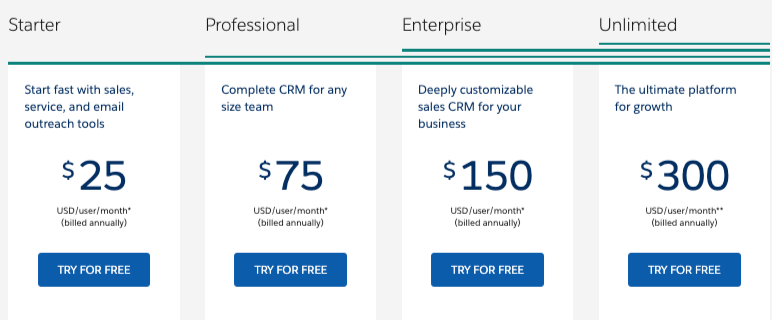
Value aside, one thing I think could tip some potential customers away from Zendesk and toward Salesforce is Zendesk's occasionally discernable slant toward issue management. Most of the time, this isn't very obvious or problematic—you still get modules for general customer management components like deals, leads, pipelines, and tasks, so sales and marketing teams should get what they need.
But there are two key places where a focus on issues could become an issue: automations (which I covered above) and reporting.
Reports
In general, I think Zendesk's reporting module (Explore) is a strong one. I like that reporting gets its own dashboard, where you can easily access report templates, related cloud data, and past reports. That said, the native reporting capabilities seem pretty skewed toward issues-related metrics like solved tickets, time in status, call activity, and chatbot performance.
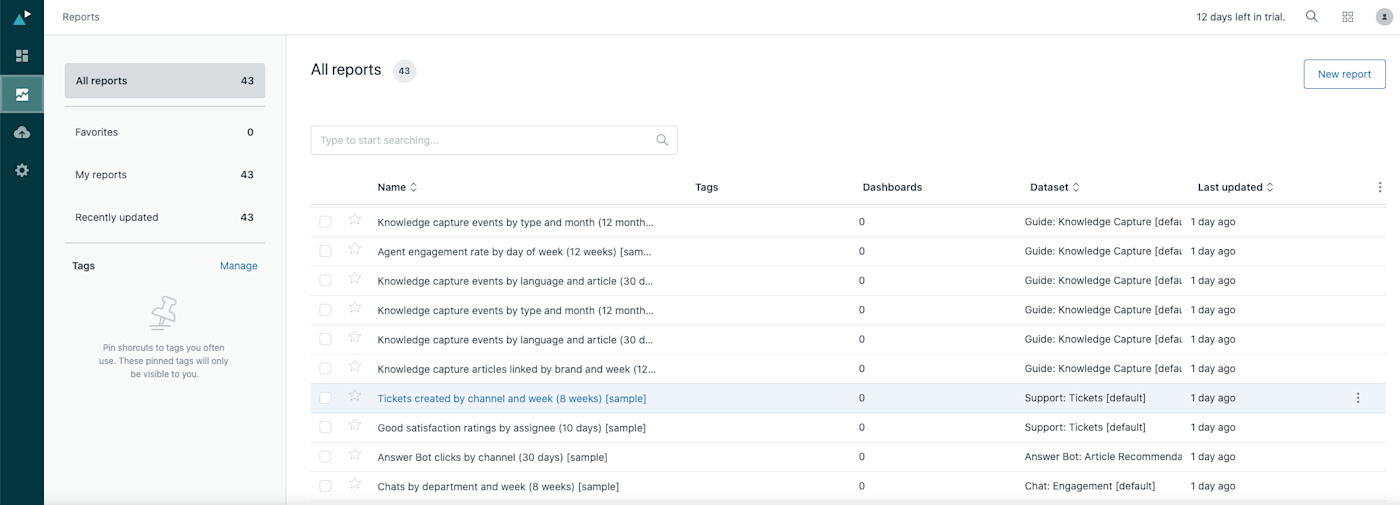
When building reports, there are just four sales-related reporting datasets compared to 12 service-related datasets. Since users can create custom reports, this may not turn out to be a major issue, but I can see where it may be more limiting if you're looking for rich, intuitive reporting on a breadth of datasets.
Salesforce's report building module feels a little more expansive, with dozens of report types to start from.

Again, since both allow you to create custom reports, this may not be too problematic, but Salesforce feels more naturally positioned for a wide range of reporting applications.
Both platforms integrate with Zapier
Zendesk and Salesforce both have thousands of native integrations to make connecting your other external tools a breeze.
They also both integrate with Zapier, so you can connect them to any apps that aren't natively integrated with Zendesk and Salesforce and create more complex automations for apps that are. Learn more about how to automate Zendesk Sell and how to automate Salesforce, or get started with one of the pre-built workflows below.
Zapier is the leader in no-code automation—integrating with 5,000+ apps from partners like Google, Salesforce, and Microsoft. Build secure, automated systems for your business-critical workflows across your organization's technology stack. Learn more.
Zendesk vs. Salesforce: Which is best for you?
Still deciding between Zendesk vs. Salesforce? I'll sum up all the above for you:
Dollar for dollar, Zendesk gives you better UX, many similar features, a slight slant toward issue management in its reporting, and more limited automation functionality at a lower monthly cost.
Salesforce gives you more robust reporting, more sophisticated automation, and a more expansive suite of additional cloud offerings at scale for a higher monthly cost.
These are both high-quality platforms that now have some of the industry's best AI CRM tools, so I don't really think you could go wrong with either choice.
Related reading:
